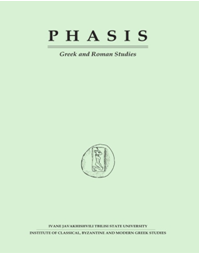This is an outdated version published on 2024-08-16. Read the most recent version.
Zu Ovids Menschenbild in den Metamorphosen
DOI:
https://doi.org/10.48614/phasis.18.2015.6-24Abstract
The creation and destiny of man are discussed in Chapters 1 and 2 (Ov. Met. 1, 76-88) and compared to Pico della Mirandola (De dignitate hominis, 1, pp. 4-6), according to whom animals have their determined place within nature, while man is free to choose his own place and move either upwards (towards the gods) or downwards (towards animals, plants, stones). Chapter 3 is devoted to the double metamorphosis of Philemon and Baucis in the central Book 8 (703-24) as compared to the double metamorphosis of Cadmus and Harmonia (Book 4) and the double apotheosis of Romulus and Hersilia (Book 14). These myths reveal the cultural importance of sexual polarity in Ovid's view of man. A rare type of texts is discussed in Chapter 4: reports of apotheoses related in the first person (Glaucus, Hippolytus). All this sheds light on the last paragraph of the Metamorphoses and on the poem's overall structure.Downloads
Published
2015-02-16 — Updated on 2024-08-16
Versions
- 2024-08-16 (3)
- 2024-08-16 (2)
- 2015-02-16 (1)
Issue
Section
Articles
License
Copyright (c) 2015 PHASIS

This work is licensed under a Creative Commons Attribution-NonCommercial 4.0 International License.


